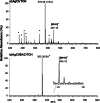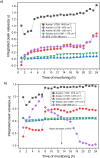Development of super nanoantimicrobials combining AgCl, tetracycline and benzalkonium chloride
- PMID: 38861141
- PMCID: PMC11166621
- DOI: 10.1186/s11671-024-04043-3
Development of super nanoantimicrobials combining AgCl, tetracycline and benzalkonium chloride
Abstract
In this work, we demonstrate that a simple argentometric titration is a scalable, fast, green and robust approach for producing AgCl/antibiotic hybrid antimicrobial materials. We titrated AgNO3 into tetracycline hydrochloride (TCH) aqueous solution, thus forming AgCl/TCH in a one-step procedure. Furthermore, we investigated the one-pot synthesis of triply synergistic super-nanoantimicrobials, combining an inorganic source of Ag+ ions (AgCl), a disinfecting agent (benzyl-dimethyl-hexadecyl-ammonium chloride, BAC) and a molecular antibiotic (tetracycline hydrochloride, TCH). Conventional antimicrobial tests, industrial biofilm detection protocols, and in situ IR-ATR microbial biofilm monitoring, have been adapted to understand the performance of the synthesized super-nanoantimicrobial. The resulting hybrid AgCl/BAC/TCH nanoantimicrobials are found to be synergistically active in eradicating Salmonella enterica and Lentilactobacillus parabuchneri bacteria and biofilms. This study paves the way for the development of a new class of super-efficient nanoantimicrobials that combine relatively low amounts of multiple active species into a single (nano)formulation, thus preventing the development of antimicrobial resistance towards a single active principle.
Keywords: AgCl; Antibiotic; Bioactive surfactant; Biofilm; Nanoparticles; Synergistic antimicrobials.
© 2024. The Author(s).
Conflict of interest statement
The authors declare that they have no known competing financial interests or personal relationships that could have appeared to influence the work reported in this research article.
Figures






Similar articles
-
Green Synthesis and Characterization of Antimicrobial Synergistic AgCl/BAC Nanocolloids.ACS Appl Bio Mater. 2022 Jul 18;5(7):3230-3240. doi: 10.1021/acsabm.2c00207. Epub 2022 Jun 23. ACS Appl Bio Mater. 2022. PMID: 35738566 Free PMC article.
-
A scalable route to quaternary ammonium-functionalized AgCl colloidal antimicrobials inhibiting food pathogenic bacteria and biofilms.Heliyon. 2024 Feb 1;10(3):e25260. doi: 10.1016/j.heliyon.2024.e25260. eCollection 2024 Feb 15. Heliyon. 2024. PMID: 38327442 Free PMC article.
-
Antimicrobial Efficiency of Chitosan and Its Methylated Derivative against Lentilactobacillus parabuchneri Biofilms.Molecules. 2022 Dec 7;27(24):8647. doi: 10.3390/molecules27248647. Molecules. 2022. PMID: 36557784 Free PMC article.
-
Ag-Based Synergistic Antimicrobial Composites. A Critical Review.Nanomaterials (Basel). 2021 Jun 27;11(7):1687. doi: 10.3390/nano11071687. Nanomaterials (Basel). 2021. PMID: 34199123 Free PMC article. Review.
-
Therapeutic Nanotechnology for Bone Infection Treatment - State of the Art.Curr Drug Deliv. 2018;15(7):941-952. doi: 10.2174/1567201815666180228162949. Curr Drug Deliv. 2018. PMID: 29493453 Review.
References
-
- Majumder S, Naskar B, Ghosh S, Lee C-H, Chang C-H, Moulik SP, Panda AK. Synthesis and characterization of surfactant stabilized nanocolloidal dispersion of silver chloride in aqueous medium. Colloids Surf A. 2014;443:156–163. doi: 10.1016/j.colsurfa.2013.10.064. - DOI
-
- Jack A, Campbell C The threat of antibiotic resistance—in charts, (2020). https://www.ft.com/content/d806dcf5-23f8-4714-ad04-ca11a66061e2 (accessed January 23, 2021).
Grants and funding
LinkOut - more resources
Full Text Sources
Miscellaneous
